


Reduction of dichromate - different colors
The reduction of dichromate in an acidic environment is a simple and well known demonstration, often given in high schools. The reduction of the orange dichromate ion to the frequently as green denoted trivalent chromium ion is a nice experiment on its own. This justifies the use of this simple reaction in high schools.
When the reaction is studied in more detail, then another interesting property of chromium can be observed. The color of trivalent chromium certainly is not constant. Especially, when trivalent chromium is formed from a compound with an other oxidation state of chromium, then many different colors can be obtained. This experiment shows that all kinds of greens, blues and violets can be obtained. The reduction of the dichromate is accompanied with complex-formation. The chromium (III) ions are not formed as free ions, but in a coordination-complex. The supposed spectator ions in the redox reaction in reality are not simply spectator ions at all. They have a strong influence on the reaction and the reaction product!
![]()
![]() Required
chemicals:
Required
chemicals:
-
potassium dichromate (sodium dichromate or ammonium dichromate is suitable as well)
- ethanol (colorless denatured alcohol is suitable as well)
- dilute hydrochloric acid, 10-15% by weight
- dilute sulphuric acid, 10 - 20% by weight
- dilute nitric acid, 10 - 20% by weight
- potassium metabisulfite (sodium or potassium sulfite also is suitable)
![]() Required
equipment:
Required
equipment:
-
test tubes
![]() Safety:
Safety:
- The dilute acids are corrosive
- Dichromates are toxic.
 Probably they are carcinogens.
Probably they are carcinogens. - Ethanol is flammable.
![]() Disposal:
Disposal:
- The chromium waste should not be flushed down the drain. Keep aside in a heavy-metal waste container and bring to a waste processing facility.
![]()
Effect of acid, used for supporting the redox reaction
In the first part of this experiment, the reductor for the dichromate is kept the same and the supporting acid is varied. It is shown that the anionic part of the supporting acid has a strong influence on the reaction products and on the speed of the reaction.
![]() Prepare
three solutions of potassium dichromate in a few ml of the dilute acids in three
separate test tubes. The picture below shows these three solutions. The
concentration of the dichromate is approximately the same in all three test
tubes. The left one is in dilute nitric acid, the middle one is in dilute
sulphuric acid and the right one is in dilute hydrochloric acid.
Prepare
three solutions of potassium dichromate in a few ml of the dilute acids in three
separate test tubes. The picture below shows these three solutions. The
concentration of the dichromate is approximately the same in all three test
tubes. The left one is in dilute nitric acid, the middle one is in dilute
sulphuric acid and the right one is in dilute hydrochloric acid.
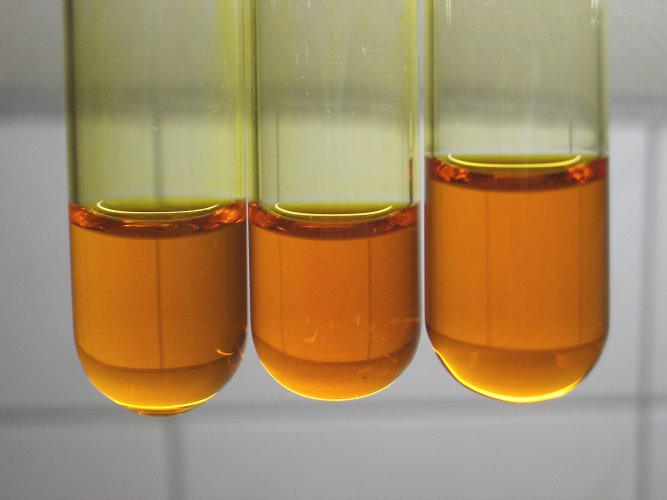
![]() To each
of the test tubes add approximately 0.7 ml ethanol. This results in quick
reduction of the dichromate in the left two test tubes and a slight warming up
of the liquid in these two test tubes. The dichromate in the test tube with the
dilute hydrochloric acid also is reduced, but this takes several minutes. After
approximately 30 seconds, the dichromate in the middle test tube is completely
reduced. In the left test tube the reaction also has gone close to completion,
although still a brown/orange hue can be observed. The reaction in the right
test tube proceeds much slower. This is shown by the left picture, given below.
The right picture shows the same test tubes after 5 minutes. After 5 minutes all
dichromate is reduced. As the pictures show, the chromium (III) also is much
darker than the dichromate and hardly any light is transmitted though the
solutions.
To each
of the test tubes add approximately 0.7 ml ethanol. This results in quick
reduction of the dichromate in the left two test tubes and a slight warming up
of the liquid in these two test tubes. The dichromate in the test tube with the
dilute hydrochloric acid also is reduced, but this takes several minutes. After
approximately 30 seconds, the dichromate in the middle test tube is completely
reduced. In the left test tube the reaction also has gone close to completion,
although still a brown/orange hue can be observed. The reaction in the right
test tube proceeds much slower. This is shown by the left picture, given below.
The right picture shows the same test tubes after 5 minutes. After 5 minutes all
dichromate is reduced. As the pictures show, the chromium (III) also is much
darker than the dichromate and hardly any light is transmitted though the
solutions.
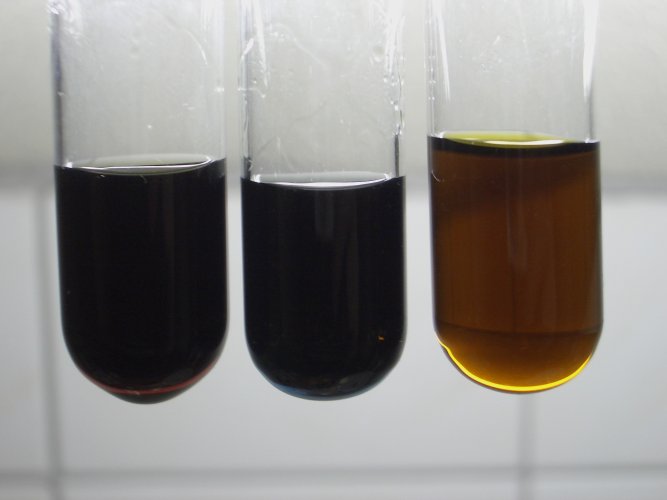
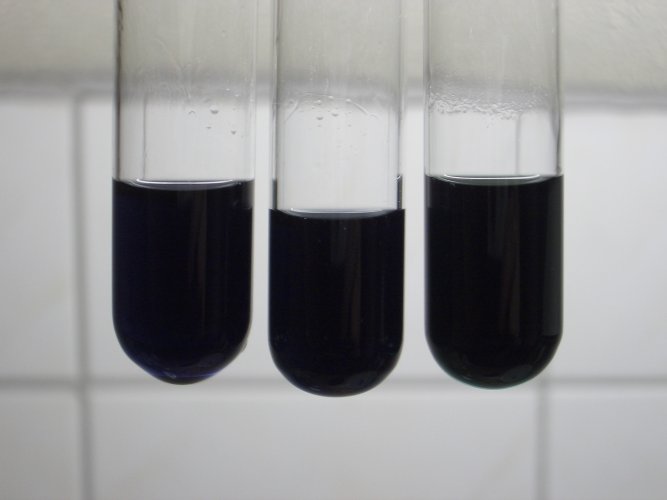
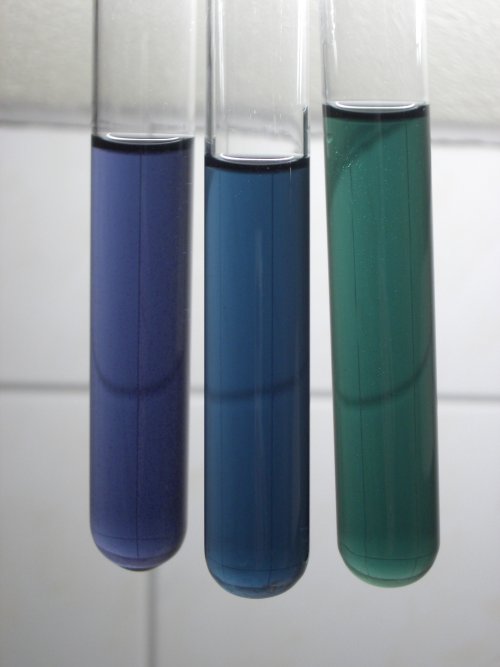 In
order to clearly see the color of the produced solutions, the liquids need to be
diluted. After dilution, one can clearly see that the color of the reaction
product is quite different for each of the three acids. Especially the test tube
with the dilute hydrochloric acid shows a remarkably different color.
In
order to clearly see the color of the produced solutions, the liquids need to be
diluted. After dilution, one can clearly see that the color of the reaction
product is quite different for each of the three acids. Especially the test tube
with the dilute hydrochloric acid shows a remarkably different color.
As the picture shows, the anionic part from the acid has a strong influence on the final reaction product. The nitrate, sulfate or chloride ions certainly cannot simply be regarded as spectator ions in the redox reaction between ethanol and dichromate ion. The acid is required for this reaction, but the anion also has effect, both on the speed of the reaction and on the final products formed. The color differences can be explained by assuming the formation of different complexes.
![]()
Effect of reductor
In this part of the experiment, the reductor, used to reduce the dichromate is varied and the supporting acid is kept constant.
![]() Prepare
a solution of potassium dichromate in dilute sulphuric acid and divide this
solution over two test tubes. Only a small amount of dichromate is needed. Too
much dichromate makes it harder to see the final color of the reaction products,
because of the dark colors.
Prepare
a solution of potassium dichromate in dilute sulphuric acid and divide this
solution over two test tubes. Only a small amount of dichromate is needed. Too
much dichromate makes it harder to see the final color of the reaction products,
because of the dark colors.
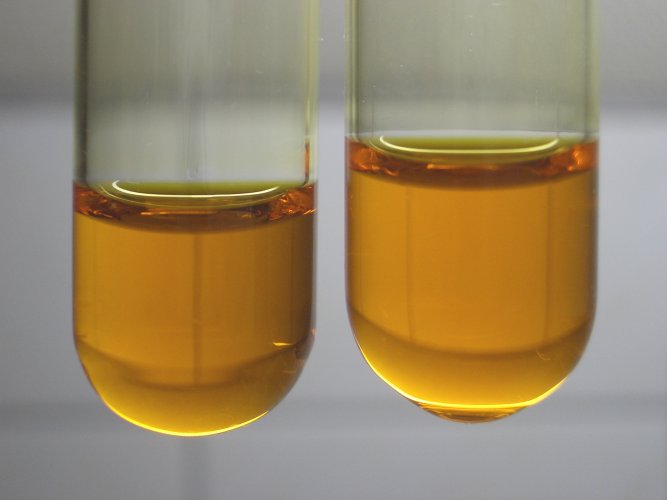
![]() To the
left test tube add 1 ml of a fairly concentrated solution of potassium
metabisulfite or sodium sulfite, slightly acidified with some dilute sulphuric
acid. To the right test tube add approximately 0.5 ml of ethanol. The dichromate
in the left test tube is reduced at once, the dichromate in the right test tube
also is fairly quickly reduced, but this reaction is not instantaneous. The
result is as follows:
To the
left test tube add 1 ml of a fairly concentrated solution of potassium
metabisulfite or sodium sulfite, slightly acidified with some dilute sulphuric
acid. To the right test tube add approximately 0.5 ml of ethanol. The dichromate
in the left test tube is reduced at once, the dichromate in the right test tube
also is fairly quickly reduced, but this reaction is not instantaneous. The
result is as follows:
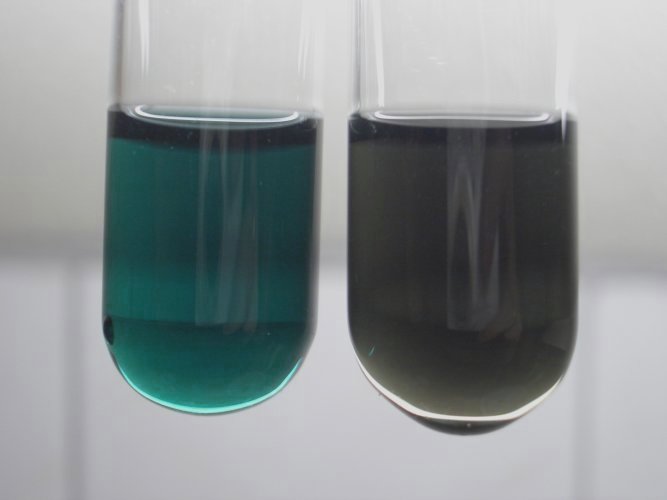

The left picture shows the contents of both test tubes a few seconds after adding the reducing agents (left: sulfite, right: ethanol). The right picture shows the same test tubes two minutes later.
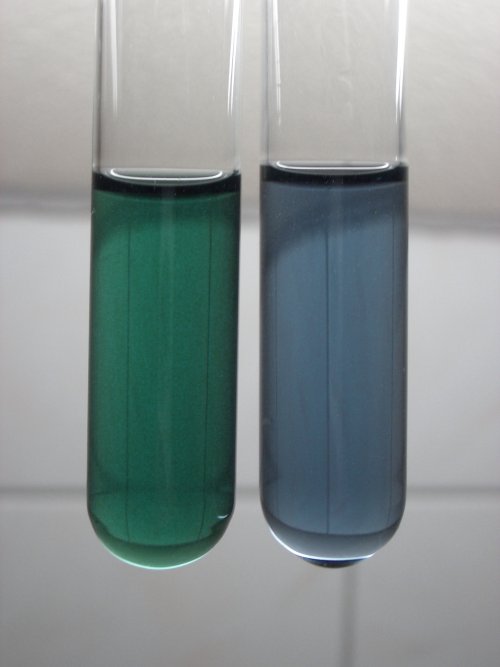
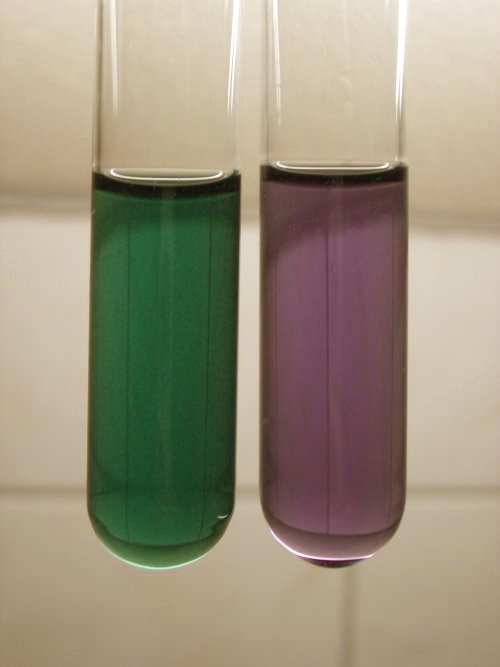 When
the contents of the test tubes is diluted, then the liquid with the sulfite is a
bright green liquid, with a slight bluish hue. The liquid with the ethanol is a
dull blue liquid. The latter also is the color of a solution of a plain chromium
(III) salt in water.
When
the contents of the test tubes is diluted, then the liquid with the sulfite is a
bright green liquid, with a slight bluish hue. The liquid with the ethanol is a
dull blue liquid. The latter also is the color of a solution of a plain chromium
(III) salt in water.
It is quite remarkable that the difference between the two reactions is so large. The reduction of the sulfite apparently is accompanied with formation of a complex.
When the liquids are viewed under another light source (tungsten yellow light), then the color of the right test tube looks quite different. It is more violet/purple. The color of the left test tube still looks green.
![]()
Discussion of the results
Reduction of dichromate in acidic media often is described by the following half-reaction:
Cr2O72-(aq) + 14H+(aq) + 6e- → 2Cr3+(aq) + 7H2O
The ion Cr2O72-(aq) is bright orange and the ion Cr3+(aq) is dull bluish/violet.
In many cases, the half-reaction, given above, apparently is too much of a simplification and in reality things are more complex.
When dichromate is reduced by ethanol in nitric acid or sulphuric acid, then the half-reaction is a reasonable approximation. The observed colors are close to the color of a plain hydrated chromium (III) salt, when it is dissolved in water. When hydrochloric acid is used as the donor for the required H+ ions, then the newly formed chromium ions are coordinated to chloride ions and a green compound is formed. When dilute hydrochloric acid is added to a dull bluish solution of a chromium (III) salt, then no change of color from bluish/violet to green is observed, so one can conclude that the formation of a chloride-chromium (III) complex is combined with the redox reaction.
Reduction of dichromate by sulfite in acidic media can better be regarded as reduction of dichromate by sulphur dioxide. When dichromate is reduced by sulphur dioxide, then a green chromium (III) compound is formed, regardless of the acid, used for supplying the H+ ions. Probably a chromium-sulfate complex is formed, with the sulphur dioxide being transformed to sulfate by transfer of electrons to the SO2 molecule and addition of oxygen ligands from the dichromate ion. On formation of the chromium (III) core, the newly formed sulfate ion may be coordinated. More research, however, is necessary to see whether this theory is correct or not.
The observation, that reduction and coordination are combined in a single reaction, is used in preparative chemistry. Frequently, chromium (III) complexes are made, either by reducing dichromate by a certain reductor, or in the presence of a certain ligand, or by oxidizing chromium (II) in the presence of a certain ligand.
Chromium (III) complexes are inert, meaning that ligands are exchanged only very slowly. This also explains why simple addition of hydrochloric acid to a plain aqueous chromium (III) solution does not result in formation of the green chloro-complex. The Cr3+(aq) ion, better described as Cr(H2O)63+ is quite stable and the H2O ligands are only replaced slowly. When, however, chromium (III) is formed, then the ligands are coordinated on formation and then the presence of a certain ligand may favor the formation of certain complexes over formation of other complexes.